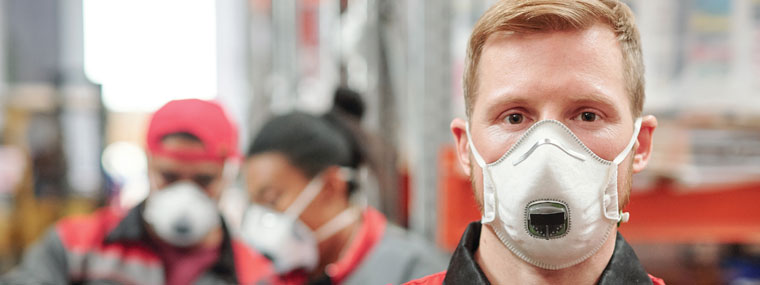
Biorisk Mitigation
A Partnership Between Regulators and Employers
By Diane M. Calabrese / Published February 2021

Crime scenes and waste spills are among the obvious risk-filled environments. Not all risky places can be so easily identified.
A contractor should assume nothing. When assessing the scope and planning the approach to a project, get relevant information. Does a parking garage by day become at night a sheltering spot for homeless people or a site for drug use?
“Contractors may have no idea that they are cleaning a biohazard, but some locations should raise red flags that there is a high probability of risk,” says Linda Chambers, brand and sales manager, Georgia Chemical Equipment (GCE) in Norcross, GA. She points to the parking deck as a site that could pose risks.
In inner city areas and around public transportation areas, certain parts of a parking structure may be less safe. Chambers says that stairwells often become soiled with urine and feces,
as well as littered with hypodermic needles from drug activity.
Sadly, in some areas, a contractor may not even know a crime has occurred in a structure. Chambers reminds us of the “violent activities” that “happen daily at apartment complexes, storefronts, gas stations, convenience stores, bars, and restaurants,” especially in metropolitan areas.
Cleanup is not always a priority following a crime. “Frequently, police do not send anyone out to clean the sites of blood, and evidence of these shootings can be seen for days later,” explains Chambers.
Consequently, a contractor must be proactive. “Walk around the site looking for evidence of biohazard activity,” says Chambers. “Do a google search of the address. It very likely could show up in local news posts explaining what may recently have gone on there.”
And ask for information from those familiar with a site. Employees of surrounding establishments will know if the area is a gathering place for the homeless or loiterers, explains Chambers.
Some of the same safety measures contractors follow when using chemicals do double-duty as protection from pathogens and biohazards. “Always wear gloves when picking up trash by hand,” says Chambers. “Wear masks when using surface cleaners or when spray from pressure washer use could be vaporized and inhaled.”
Preparation for the worst should be part of routine training. “With most biohazards, procedures should be known to employees regarding how to cope as a situation arises—and touched on in a meeting at least once a year,” says Chambers.
“Most businesses are not going to have to deal with a situation that includes dealing with bloodborne exposures,” says Chambers. “Today with COVID-19, every workplace needs to assess procedures as conditions change. This could be only monthly to weekly but even daily if factors are changing, like a spike in local positive cases or if an employee is found to be positive or exposed to COVID-19.”
The pool of employees that must be trained in how to mitigate chemical risks is a large one. It is a bit different for biological risks.
“Training should already be going on by all companies that have employees who come in contact with hazardous products, like cleaning chemicals,” says Chambers. The hazardous products training includes training in GHS labels and SDSs, explains Chambers.
“You only have to add bloodborne training when there is a high likelihood the employees could be exposed, like a nurse, EMT, healthcare worker, etc.,” explains Chambers. “Now, if in your job-place assessments you are finding possible exposure could exist, then, yes, any employee who could be affected must have training per OSHA regulations before jobs are performed in those areas.”
OSHA, CDC, and NIOSH [National Institute for Occupational Safety and Health] provide guidance for almost every situation. For example, NIOSH offers advice for those working in a disaster area that may contain human remains.
Being near human remains is generally not dangerous to recovery workers, including contractors. Even though the remains may be from individuals who had bloodborne viruses, such as hepatitis and HIV, or bacterial agents that cause diarrheal diseases, being near the remains is not particularly risky.
Riskier is the range of well-known threats, such as sharp debris, unstable structures, downed power lines, and breaches at industrial facilities. Contaminated water is another significant issue.
Contractors and others who need help with training their employees can find lots of assistance. “For general hazmat DOT training for chemicals, Infotrac is a good resource,” says Chambers. She adds that contractors can find links to trainers via OSHA.gov and that many companies, such as Hazmatschool.com, offer fee-based training.
BBP or Chemical?
Which is the greater threat to employee safety and well-being, a bloodborne pathogen (BBP) or a chemical? It’s not really a competition anyone wants to have. But since the focus on chemicals has been intense in our industry, which makes good and appropriate use of chemicals, BBPs may not always get the attention they deserve.
Leighton Light, GSP, safety manager and water treatment sales, at Chappell Supply and Equipment in Oklahoma City, OK, recommends giving BBPs more attention. “I believe biological hazards are often the most overlooked hazard,” says Light.
Light notes the three most common BBPs are human immunodeficiency virus (HIV), hepatitis B virus (HBV), and hepatitis C virus (HCV). (BBPs are transmitted from person to person via direct contact with body fluids, unlike flea-borne typhus, for instance, which has an insect vector.)
A tendency to not always give BBPs the attention they require is understandable, explains Light. “It is hard to know something is a hazard when the hazard is not visible to your naked eye.”
“When you do not know if the materials have been contaminated or not, treat all materials as though they have been contaminated by biohazard material,” says Light. “This could require the need for PPE—personal protective equipment—like goggles, face-shields, nitrile or latex gloves, boots, aprons, pants, and/or jackets.”
Get it right by talking with a client about the scope of the job and the unique aspects to it. “I first start with my contact or who I am cleaning for,” says Light. “They should know what you will be washing, or they should know who to talk to about what you will be washing and whether it has been contaminated with biohazards.”
Ask about chemicals, too. “Ask for SDSs regarding the chemicals a client has used in the processes leading up to your arrival,” says Light. “Ask the person on site if any of the surfaces or materials being cleaned have had any bodily fluids on them.”
Once the risks are identified, the PPE required can be determined. Time taken to plan correctly is a must.
“Most biological risks are known or communicated when figuring out the scope of the work,” says Light. “Employers hold the responsibility for protecting their employees in regard to workplace hazards.”
Start with the information provided by OSHA and stay current with it. “OSHA’s 29 CFR 1930.1030 focuses specifically on preventing BBPs in the workplace,” says Light. “Following this standard will not only protect workers but also help keep diseases from spreading just as it did when OSHA implemented the standard back in 1991.”
Light says that contractors, manufacturers, and distributors should think broadly when deciding which employees ought to receive hazmat training. “I believe employees who have the potential to be exposed to or who sell chemicals need to have some sort of chemical or hazmat training,” says Light.
There are many good sources to turn to for help, and some were cited in the previous section. Light recommends including the local National Safety Council location as a starting point for lining up training for hazmat, BBPs, and other needs.
OSHA has some succinct and comprehensive information available for employers to assist with complying with its BBP standard. It can also provide clarification regarding rules for contractors in settings where BBPs are more common.
For example, most of the standard guidance on BBPs focuses on settings, largely health care, where there are likely to be needles or sharps [items, usually medical, capable of cutting
or puncturing] in abundance. It addresses proper handling and containment of both. The standard also advises that the employer must offer free hepatitis B vaccinations to all employees with occupational exposure.
Does the OSHA standard mean that contract cleaners working on site at hospitals must also be offered free hepatitis B vaccinations? If the employees will potentially be exposed to needles and sharps, yes.
Contaminated needles may be an infrequent concern for most contractors. But puncture from objects at job sites is not so rare. No wound should be dismissed as minor; having it checked by a medical professional will ensure that the employee is up to date on tetanus protection. The employer must set the expectations for routine first aid.
Mitigation of risks—biological, chemical, and other—is best viewed as a partnership between regulators and employers. Responsibility for maintaining a safe work environment falls on the employer, who has access to an abundance of free assistance.
Take advantage of the free consultations available from regulators. The consultations are not tied to enforcement. They are made available to help bring clarity to the murkiest and routine compliance issues.






